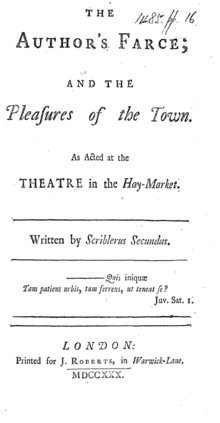
The Author's Farce and the Pleasures of the Town is a play by the English playwright and novelist Henry Fielding, first performed on 30 March 1730 at the Little Theatre, Haymarket. Written in response to the Theatre Royal's rejection of his earlier plays, The Author's Farce was Fielding's first theatrical success. The Little Theatre allowed Fielding the freedom to experiment, and to alter the traditional comedy genre. The play ran during the early 1730s and was altered for its run starting 21 April 1730 and again in response to the Actor Rebellion of 1733. Throughout its life, the play was coupled with several different plays, including The Cheats of Scapin and Fielding's Tom Thumb.
The first and second acts deal with the attempts of the central character, Harry Luckless, to woo his landlady's daughter, and his efforts to make money by writing plays. In the second act, he finishes a puppet theatre play titled The Pleasures of the Town, about the Goddess Nonsense's choice of a husband from allegorical representatives of theatre and other literary genres. After its rejection by one theatre, Luckless's play is staged at another. The third act becomes a play within a play, in which the characters in the puppet play are portrayed by humans. The Author's Farce ends with a merging of the play's and the puppet show's realities.
The play established Fielding as a popular London playwright, and the press reported that seats were in great demand. Although largely ignored by critics until the 20th century, most agree that the play is primarily a commentary on events in Fielding's life, signalling his transition from older forms of comedy to the new satire of his contemporaries. Fielding's play within a play satirised the way in which the London theatre scene, in his view, abused the literary public by offering new and inferior genres. The Author's Farce is now considered to be a critical success and a highly skilled satire.